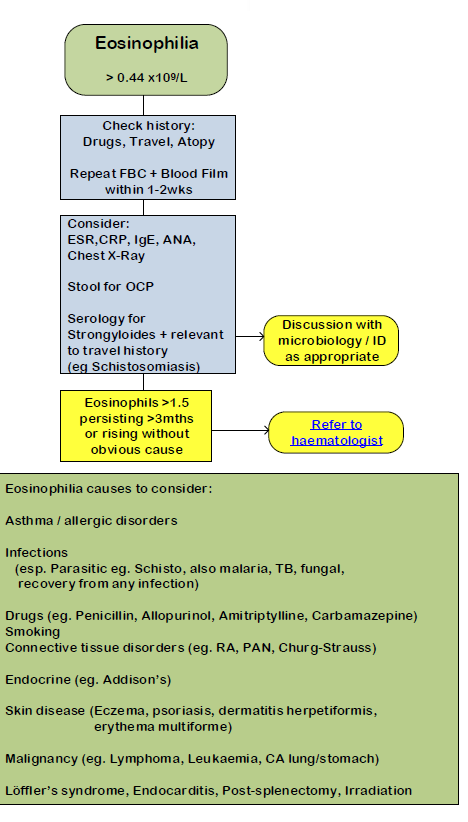eosinophilia (blood)
Last edited 02/2023 and last reviewed 02/2023
Eosinophilia is a raised eosinophil count (1,2,3,4)
This occurs where the eosinophil count is greater than 0.44 x 10^9/l (3)
- however has been noted that the normal range for a peripheral blood eosinophil count in healthy individuals is generally defined internationally as 0.05-0.5×10^9/L (4)
- eosinophilia is a raised number of eosinophils in peripheral blood (>0.5×10^9/L)
- hypereosinophilia is >=1.5×109/L on two tests separated by at least one month
- eosinophil count can vary with extremes of age
- eosinophil levels are higher in neonates than adults and gradually reduce in older people.
It may be a feature of the following conditions:
- asthma and allergic disorders - asthma, hypersensitivity, drugs, angioneurotic oedema
- parasitic infections - especially schistosomiasis, echinococciasis
- polyarteritis nodosa
- Churg-Strauss syndrome
- Addison's disease
- skin disease - pemphigus, urticaria, eczema, dermatitis herpetiformis, erythema multiforme
- malignancy:
- Hodgkin's disease
- carcinoma
- haematological malignancies:
- chronic myeloid leukaemia
- other myeloproliferative syndromes
- eosinophilic leukaemia
- Loeffler's syndrome
- Loeffler's endocarditis
- scarlet fever
- irradiation
- during convalescence from any infection
- hypereosinophilic syndrome
- post-splenectomy
- cholesterol emboli syndrome
- drugs that may cause raised eosinophil count include (1,2,3,4):
- antimicrobials
- such as penicillins, cephalosporins, nitrofurantoin, tetracyclines, daptomycin, fluoroquinolones
- sulphonamides
- such as sulfasalazine, septrin, dapsone
- ranitidine
- allopurinol
- angiotensin converting enzyme (ACE) inhibitors
- anticonvulsants
- such as phenytoin, carbamazepine, lamotrigine
- antiretrovirals
- nevirapine, abacavir
- non-steroidal anti-inflammatory drugs (NSAIDs)
- methotrexate
- interleukin-2 (IL-2)
- antimicrobials
If raised eosinophil count in an adult (3):

Factors such as intercurrent steroid treatment and bacterial or viral infection can transiently lower eosinophil counts (4)
Reference:
- Felig P et al (2001) Endocrinology and Metabolism. McGraw-Hill.
- Hart FD (Ed) (2005). French's Index of Differential Diagnosis.
- NHS Camden CCG. Abnormal FBC guidance - for adults (Accessed 30/10/19)
- Thakker C, Booth H L, Lambert J, Morgan S, Checkley A M. Investigating eosinophilia BMJ 2023; 380 :e070295 doi:10.1136/bmj-2022-070295